How to make simple Malaysian Nasi Ulam (Herb Rice Salad)
February 07, 2024
Asian Herbs Rice Salad is one of Malaysian favorite rice dishes, locally known as Nasi Ulam
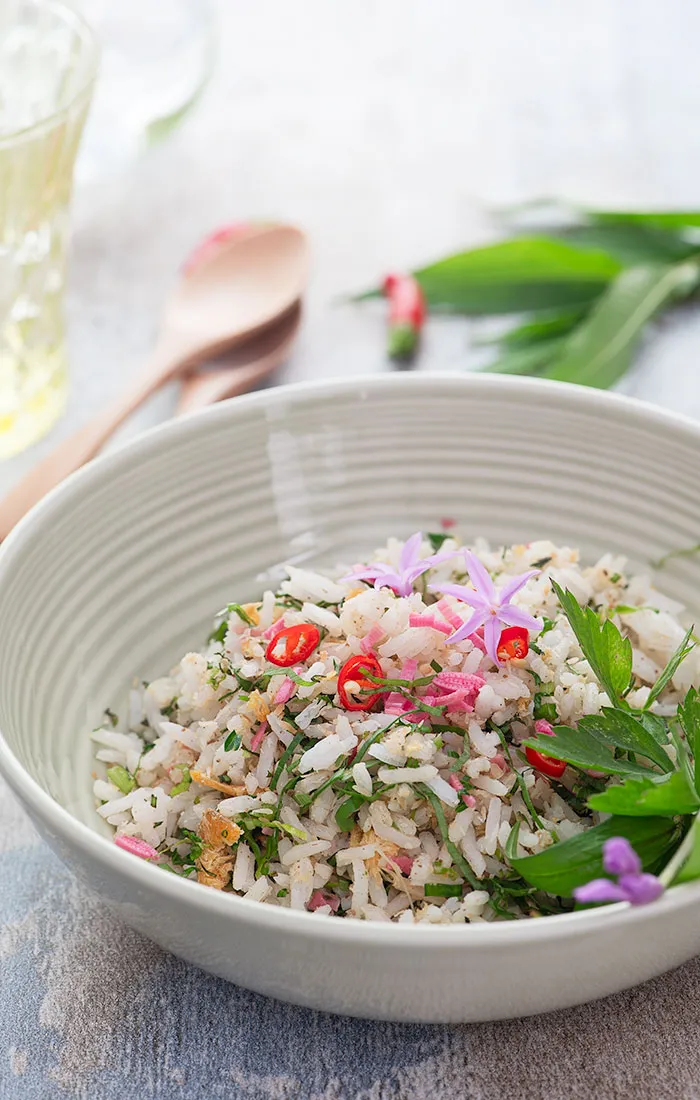
Nasi is a Malay word for cooked rice.
Ulam is generally green plants or herbs that we eat raw with rice and sambal belacan.
This rice dish, known as Nasi ulam is a Malay cuisine, that uses a lot of wonderful fresh herbs.
This Malay food (Nasi Ulam) could well be described as Herbed Rice Salad!
Nasi ulam can be served as side dishes or have them as your main meal.
That is Nasi Kerabu!
Nasi kerabu is different from Nasi ulam.
Nasi kerabu is blue-colored rice (using blue pea flowers to the rice), served with fresh raw herbs, either fried chicken or fish, hot chili sambal, and some curry.
While nasi ulam is room temperature cooked steamed rice, mix it with finely chopped Asian herbs.
Herb rice salad is an easier way to describe nasi ulam!

For my nasi ulam, I used whatever was available during the season.
a) Turmeric leaf (daun kunyit)
b) Vietnamese mint (daun kesum) also known as laksa leaves or rau ram in Vietnamese.
c) Betel leaves (daun kaduk)
d) Thai basil or Italian basil leaves.
Even though both basil do not give the same flavor, I have used Italian basil in my nasi ulam before, and it worked well with other Asian herbs.
e) Parsley (worked just as well with other Asian herbs)
f) Mint
g) Coriander leaves
h) Bunga kantan (torch ginger flower)
i) Lemongrass. Use the white part of lemongrass.
j) Indian pennywort leaves (daun pegaga)
Do note that Indian pennywort is bitey and has a slightly bitter aftertaste, so use it sparingly.
k) Kaffir lime leaf.
l) Spring onion (green onion), this is optional.
m) chili is optional but nice to add to nasi ulam for that extra heat.
I feel that the taste kaffir lime leaf is too strong, that it overcomes the flavors of other herbs mentioned above.
The best part of this Asian Herbs Rice Salad / Nasi Ulam, apart from being addictive, there are no set rules of what type of herbs you must add to the bowl.
You can add anything that you like, in moderation of course!
My advice is to get to know the herbs before adding to your cold-cooked rice.

Pan-fry desiccated coconut until golden brown, and set aside

Pan-roast dried shrimp that has been washed, and soaked before pan-roasting.
Select your herbs of choice.

Vietnamese mint (rau ram) or daun kesum.

Daun selom is hard to find in Perth.
It is also known as water dropworts or water parsley.
In Korea, it is known as Minari (미나리).

Coriander leaves.
You can omit coriander, it will not 'water down' the taste of this nasi ulam!
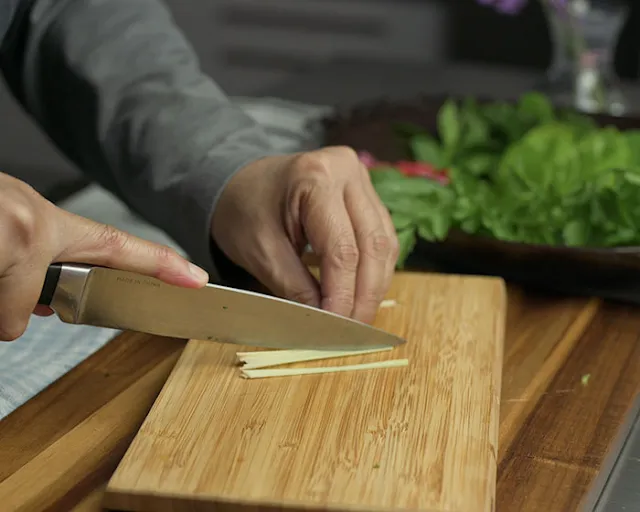
Use the white part of lemongrass.

Turmeric leaves.
This too can be omitted if you can not find fresh turmeric leaves.

Daun kadok also known as wild betel or pepper leaves.
Note this is seasonal too.

Use spring onion or shallot.

Parsley, basil, sweet Thai basil, and curly parsley can be added too.
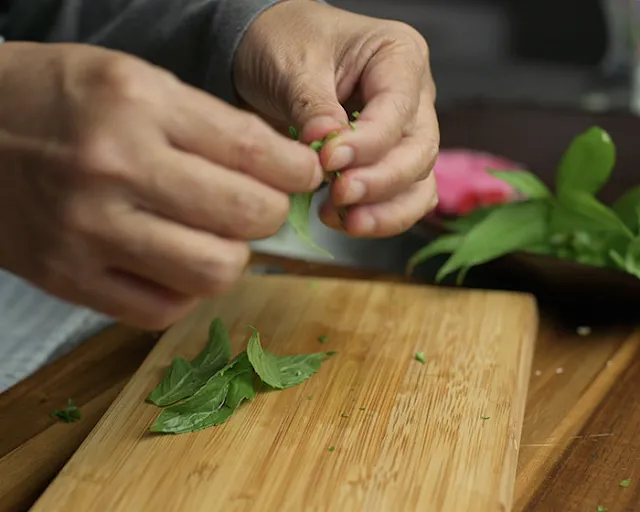
Mint is a must.
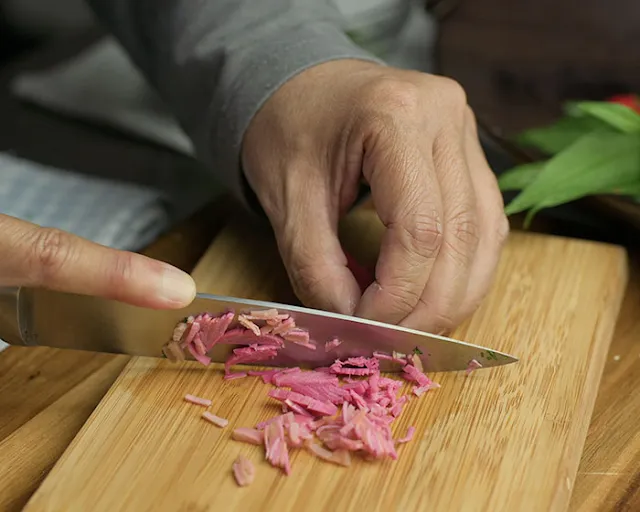
This torch ginger flower is so fragrant to be added to nasi ulam.
If you are residing in Southeast Asia, like Malaysia, Singapore, or Indonesia, fresh torch ginger flower is easy to find.
Unfortunately, this is not the case for me, I resorted to using frozen torch ginger flower.

This is optional.
I love a slight heat in my nasi ulam, so I added it anyway.
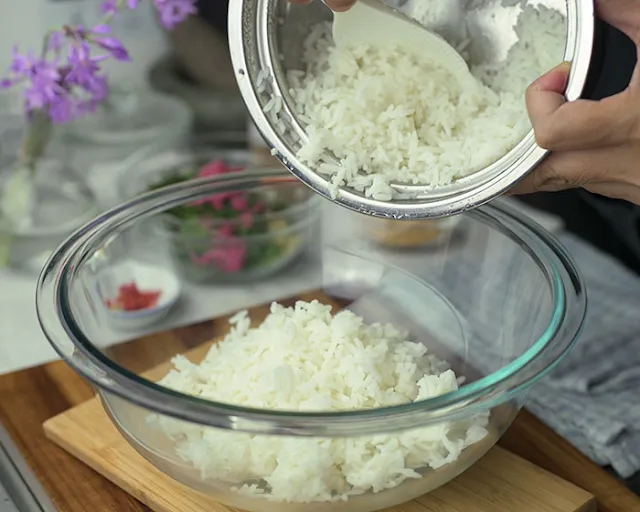
Use room-temperature cooked rice.

Add golden pan-fried desiccated coconut

Add shrimp paste granules
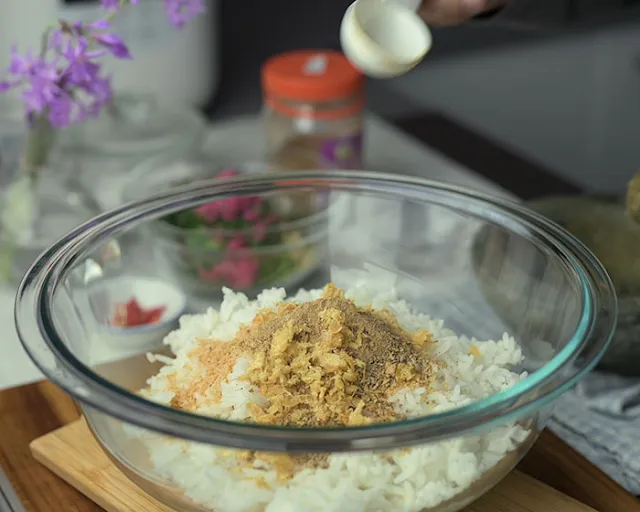
Add pounded pan-roast dried shrimps.

Add thinly sliced or finely chopped herbs.

Add salt.

Mix rice, and herbs and add a dash of white pepper.

Nasi ulam is ready to be served.
I try not to use basmati rice.
Basmati rice has less starch and makes nasi ulam taste 'dry', compared to long-grain rice.
And that is my opinion, you are welcome to use the rice of your choice.
As for jasmine rice, just in my humble opinion, that jasmine rice fragrance will overcome the fresh Asian herbs fragrances in making this nasi ulam.
Short-grain rice, medium-grain rice, or brown rice are less tasty for nasi ulam.
Take the nasi ulam out from the fridge at least 3 hours prior.
But I can almost assure you that there will be NO leftover as this nasi ulam is so very addictive!
Oh yeah... just in case you are wondering.... those tiny gorgeous purple/ violet flowers are society garlic flowers.
.. and yes it is edible


What is Nasi Ulam?
Let us look at the definition of Nasi ulam?Nasi is a Malay word for cooked rice.
Ulam is generally green plants or herbs that we eat raw with rice and sambal belacan.
This rice dish, known as Nasi ulam is a Malay cuisine, that uses a lot of wonderful fresh herbs.
This Malay food (Nasi Ulam) could well be described as Herbed Rice Salad!
Nasi ulam can be served as side dishes or have them as your main meal.
Nasi Ulam vs Nasi Kerabu
If you happen to be traveling in Malaysia, especially the Malaysian east coast, you may come across a blue-colored rice with lots of condiments.That is Nasi Kerabu!
Nasi kerabu is different from Nasi ulam.
Nasi kerabu is blue-colored rice (using blue pea flowers to the rice), served with fresh raw herbs, either fried chicken or fish, hot chili sambal, and some curry.
While nasi ulam is room temperature cooked steamed rice, mix it with finely chopped Asian herbs.
Herb rice salad is an easier way to describe nasi ulam!

What herbs to use for nasi ulam preparation?
These are some of the aromatic herbs used in nasi ulam.For my nasi ulam, I used whatever was available during the season.
a) Turmeric leaf (daun kunyit)
b) Vietnamese mint (daun kesum) also known as laksa leaves or rau ram in Vietnamese.
c) Betel leaves (daun kaduk)
d) Thai basil or Italian basil leaves.
Even though both basil do not give the same flavor, I have used Italian basil in my nasi ulam before, and it worked well with other Asian herbs.
e) Parsley (worked just as well with other Asian herbs)
f) Mint
g) Coriander leaves
h) Bunga kantan (torch ginger flower)
i) Lemongrass. Use the white part of lemongrass.
j) Indian pennywort leaves (daun pegaga)
Do note that Indian pennywort is bitey and has a slightly bitter aftertaste, so use it sparingly.
k) Kaffir lime leaf.
l) Spring onion (green onion), this is optional.
m) chili is optional but nice to add to nasi ulam for that extra heat.
I feel that the taste kaffir lime leaf is too strong, that it overcomes the flavors of other herbs mentioned above.
The best part of this Asian Herbs Rice Salad / Nasi Ulam, apart from being addictive, there are no set rules of what type of herbs you must add to the bowl.
You can add anything that you like, in moderation of course!
My advice is to get to know the herbs before adding to your cold-cooked rice.
How to make Nasi Ulam?
A list of ingredients and methods of this delicious and addictive nasi ulam recipe can be found in the recipe card below.
Pan-fry desiccated coconut until golden brown, and set aside

Pan-roast dried shrimp that has been washed, and soaked before pan-roasting.
Select your herbs of choice.

Vietnamese mint (rau ram) or daun kesum.

Daun selom is hard to find in Perth.
It is also known as water dropworts or water parsley.
In Korea, it is known as Minari (미나리).

Coriander leaves.
You can omit coriander, it will not 'water down' the taste of this nasi ulam!

Use the white part of lemongrass.

Turmeric leaves.
This too can be omitted if you can not find fresh turmeric leaves.

Daun kadok also known as wild betel or pepper leaves.
Note this is seasonal too.

Use spring onion or shallot.

Parsley, basil, sweet Thai basil, and curly parsley can be added too.

Mint is a must.

This torch ginger flower is so fragrant to be added to nasi ulam.
If you are residing in Southeast Asia, like Malaysia, Singapore, or Indonesia, fresh torch ginger flower is easy to find.
Unfortunately, this is not the case for me, I resorted to using frozen torch ginger flower.

This is optional.
I love a slight heat in my nasi ulam, so I added it anyway.

Use room-temperature cooked rice.

Add golden pan-fried desiccated coconut

Add shrimp paste granules

Add pounded pan-roast dried shrimps.

Add thinly sliced or finely chopped herbs.

Add salt.

Mix rice, and herbs and add a dash of white pepper.

Nasi ulam is ready to be served.
FAQ
What type of rice is suitable for this nasi ulam recipe?
I prefer to use long-grain white rice.I try not to use basmati rice.
Basmati rice has less starch and makes nasi ulam taste 'dry', compared to long-grain rice.
And that is my opinion, you are welcome to use the rice of your choice.
As for jasmine rice, just in my humble opinion, that jasmine rice fragrance will overcome the fresh Asian herbs fragrances in making this nasi ulam.
Short-grain rice, medium-grain rice, or brown rice are less tasty for nasi ulam.
How do I keep nasi ulam leftover?
Always keep nasi ulam leftover in an airtight container and keep refrigerated.Take the nasi ulam out from the fridge at least 3 hours prior.
But I can almost assure you that there will be NO leftover as this nasi ulam is so very addictive!
Can I microwave leftover nasi ulam?
I would not recommend heating nasi ulam in the microwave, the herbs will be cooked, but if you insist, there is no harm in doing so but the flavors might be different from the day before.Oh yeah... just in case you are wondering.... those tiny gorgeous purple/ violet flowers are society garlic flowers.
.. and yes it is edible


Delicious and yummy..!!
ReplyDelete:D
Delete